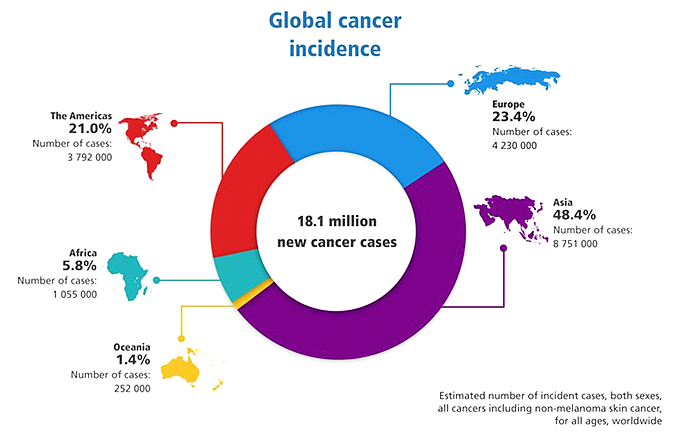
Cancer burden rises to 18.1 million new cases
and 9.6 million cancer deaths in 2018
by the World Health Organization
On September 12 the International Agency for Research on Cancer (IARC) released the latest estimates on the global burden of cancer. The GLOBOCAN 2018 database, accessible online as part of the IARC Global Cancer Observatory, provides estimates of incidence and mortality in 185 countries for 36 types of cancer and for all cancer sites combined. An analysis of these results, published today in CA: A Cancer Journal for Clinicians, highlights the large geographical diversity in cancer occurrence and the variations in the magnitude and profile of the disease between and within world regions.
Global cancer burden
The global cancer burden is estimated to have risen to 18.1 million new cases and 9.6 million deaths in 2018. One in five men and one in six women worldwide develop cancer during their lifetime, and one in eight men and one in 11 women die from the disease. Worldwide, the total number of people who are alive within five years of a cancer diagnosis, called the five-year prevalence, is estimated to be 43.8 million.
The increasing cancer burden is due to several factors, including population growth and ageing as well as the changing prevalence of certain causes of cancer linked to social and economic development. This is particularly true in rapidly growing economies, where a shift is observed from cancers related to poverty and infections to cancers associated with lifestyles more typical of industrialized countries.
Effective prevention efforts may explain the observed decrease in incidence rates for some cancers, such as lung cancer (e.g. in men in Northern Europe and North America) and cervical cancer (e.g. in most regions apart from Sub-Saharan Africa). However, the new data show that most countries are still faced with an increase in the absolute number of cases being diagnosed and requiring treatment and care.
Global patterns show that for men and women combined, nearly half of the new cases and more than half of the cancer deaths worldwide in 2018 are estimated to occur in Asia, in part because the region has nearly 60% of the global population.
Europe accounts for 23.4% of the global cancer cases and 20.3% of the cancer deaths, although it has only 9.0% of the global population. The Americas have 13.3% of the global population and account for 21.0% of incidence and 14.4% of mortality worldwide. In contrast to other world regions, the proportions of cancer deaths in Asia and in Africa (57.3% and 7.3%, respectively) are higher than the proportions of incident cases (48.4% and 5.8%, respectively), because these regions have a higher frequency of certain cancer types associated with poorer prognosis and higher mortality rates, in addition to limited access to timely diagnosis and treatment in many countries.
Major cancer types in 2018
Cancers of the lung, female breast, and colorectum are the top three cancer types in terms of incidence, and are ranked within the top five in terms of mortality (first, fifth, and second, respectively). Together, these three cancer types are responsible for one third of the cancer incidence and mortality burden worldwide.
Cancers of the lung and female breast are the leading types worldwide in terms of the number of new cases; for each of these types, approximately 2.1 million diagnoses are estimated in 2018, contributing about 11.6% of the total cancer incidence burden. Colorectal cancer (1.8 million cases, 10.2% of the total) is the third most commonly diagnosed cancer, prostate cancer is the fourth (1.3 million cases, 7.1%), and stomach cancer is the fifth (1.0 million cases, 5.7%).
Lung cancer is also responsible for the largest number of deaths (1.8 million deaths, 18.4% of the total), because of the poor prognosis for this cancer worldwide, followed by colorectal cancer (881 000 deaths, 9.2%), stomach cancer (783 000 deaths, 8.2%), and liver cancer (782 000 deaths, 8.2%). Female breast cancer ranks as the fifth leading cause of death (627 000 deaths, 6.6%) because the prognosis is relatively favorable, at least in more developed countries.
Global patterns by level of human development
For many cancers, overall incidence rates in countries with high or very high Human Development Indices (HDI) are generally 2–3 times those in countries with low or medium HDI. However, the differences in mortality rates between these two categories of countries are smaller, on the one hand because lower-HDI countries have a higher frequency of certain cancer types associated with poorer survival, and on the other hand because access to timely diagnosis and effective treatment is less common. In men, lung cancer ranks first and prostate cancer second in incidence in both developed and developing countries. In women, incidence rates for breast cancer far exceed those for other cancers in both developed and developing countries, followed by colorectal cancer in developed countries and cervical cancer in developing countries.
Global cancer patterns by sex
Lung cancer is the most commonly diagnosed cancer in men (14.5% of the total cases in men and 8.4% in women) and the leading cause of cancer death in men (22.0%, i.e. about one in 5 of all cancer deaths). In men, this is followed by prostate cancer (13.5%) and colorectal cancer (10.9%) for incidence and liver cancer (10.2%) and stomach cancer (9.5%) for mortality. Breast cancer is the most commonly diagnosed cancer in women (24.2%, i.e. about one in four of all new cancer cases diagnosed in women worldwide are breast cancer), and the cancer is the most common in 154 of the 185 countries included in GLOBOCAN 2018. Breast cancer is also the leading cause of cancer death in women (15.0%), followed by lung cancer (13.8%) and colorectal cancer (9.5%), which are also the third and second most common types of cancer, respectively; cervical cancer ranks fourth for both incidence (6.6%) and mortality (7.5%).
Worrying rise in lung cancer in women
Lung cancer is a leading cause of death in both men and women and is the leading cause of cancer death in women in 28 countries. The highest incidence rates in women are seen in North America, Northern and Western Europe (notably in Denmark and The Netherlands), China, and Australia and New Zealand, with Hungary topping the list.
“Best practice measures embedded in the WHO Framework Convention on Tobacco Control have effectively reduced active smoking and prevented involuntary exposure to tobacco smoke in many countries,” says Dr. Freddie Bray, Head of the Section of Cancer Surveillance at IARC. “However, given that the tobacco epidemic is at different stages in different regions and in men and women, the results highlight the need to continue to put in place targeted and effective tobacco control policies in every country of the world.”
“These new figures highlight that much remains to be done to address the alarming rise in the cancer burden globally and that prevention has a key role to play,” says IARC Director Dr. Christopher Wild. “Efficient prevention and early detection policies must be implemented urgently to complement treatments in order to control this devastating disease across the world.”
~ ~ ~
These announcements are interactive. Click on them for more information.













